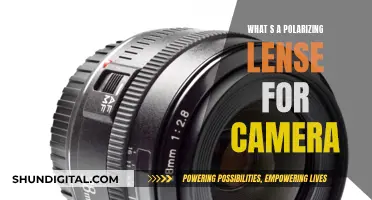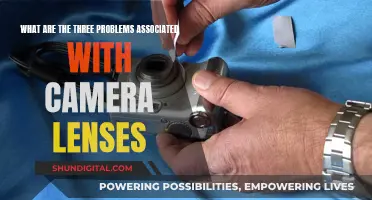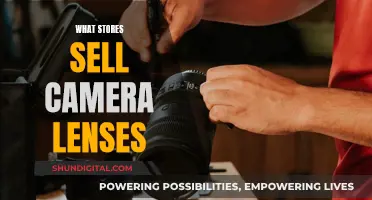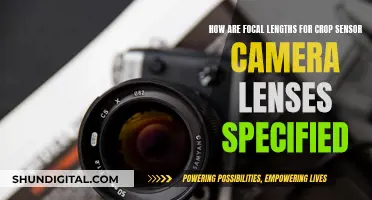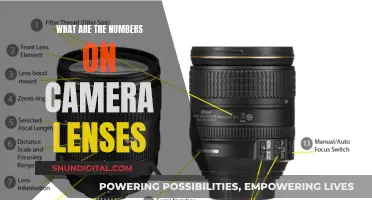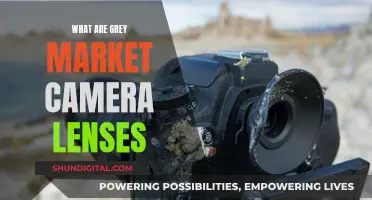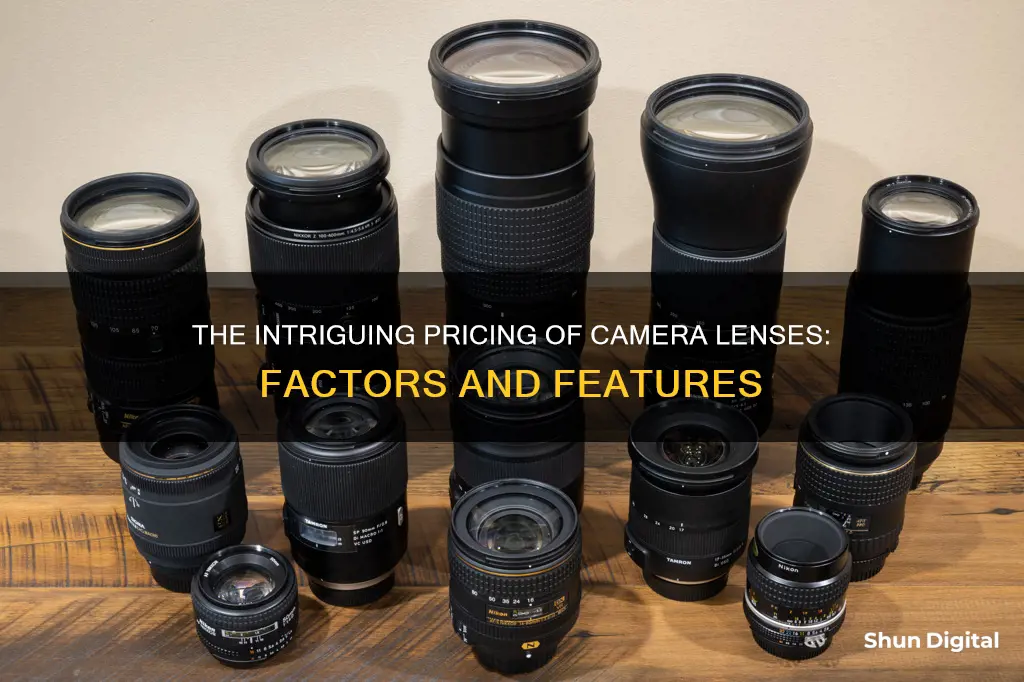
Camera lenses are priced according to various factors, including the type of lens, its quality, and the manufacturer. For instance, lenses designed for beginners typically cost between $100 and $400, while those for intermediate and advanced enthusiasts range from $200 to $700. Prices can also differ depending on whether the lens is purchased new or pre-owned. Additionally, the cost of a lens can be influenced by its focal length, with telephoto lenses generally being more expensive than standard zoom or wide-angle lenses.
| Characteristics | Values |
|---|---|
| Camera Lens Type | Beginner, Intermediate, Advanced/Pro |
| Camera Lens Price for Beginners | $100-$400 |
| Camera Lens Price for Intermediates | $200-$700 |
| Camera Lens Price for Advanced/Pro | $500 to $11,000 |
| Camera Lens Type | Standard Zoom, Wide Angle, Telephoto, Prime, Macro, Fish-eye |
| Standard Zoom Lens Price Range | $100 to $2,000+ |
| Wide Angle Lens Price Range | $100 to $2,000 |
| Telephoto Lens Price Range | $150 to $5,000+ |
| Prime Lens Price Range | $100 to $5,000+ |
| Macro Lens Price Range | $60 to $2,000+ |
| Fish-eye Lens Price Range | $60 to $2,000+ |
| Average Camera Lens Price | Varies depending on the type of camera and the quality of the lens |
What You'll Learn

Camera lens pricing depends on the type of camera
The type of camera lens also plays a significant role in determining the price. Standard zoom or wide-angle lenses typically range from $100 to $2,000 or more. Telephoto lenses are slightly more expensive, starting at $150 and going up to $5,000 or more. Prime lenses, which offer a fixed focal length and high-quality optics, can cost anywhere from $100 to $5,000 or more.
Other specialty lenses include macro lenses for extreme close-ups and fish-eye lenses that create a distorted bubble effect. These lenses can range from $60 to $2,000 or more.
It is worth noting that the camera brand can also impact the price of the lens. Lenses manufactured by the same company as the camera body tend to be more expensive but often provide better sharpness and lower image distortion. Third-party manufacturers offer more affordable options, but compatibility with the camera body must be ensured.
Additionally, the features and build quality of the lens can drive up the price. For example, lenses with features like image stabilisation (IS), autofocus, and weatherproofing tend to be more expensive than basic manual focus lenses.
When purchasing a camera lens, it is essential to consider your needs and budget. While cheaper lenses may be tempting, investing in a quality lens can significantly impact the final image.
Asurion: Cracked Camera Lens Coverage and Claims
You may want to see also

The cost of lenses for beginners vs. pros
The cost of camera lenses varies depending on the user's skill level and the quality of the lens. Camera lenses for beginners typically cost between $100 and $400, with options available from major camera brands such as Canon, Nikon, and Sony. These lenses may be referred to as "kit" lenses and are designed to help new photographers get started without breaking the bank.
For intermediate and advanced hobbyist photographers, the average lens price increases to between $200 and $700. At this price point, photographers can expect improved image quality, faster maximum apertures, and more durable builds.
Professional-grade lenses, on the other hand, can cost anywhere from $500 to a staggering $11,000. These lenses offer the best image quality, the widest maximum lens openings, and the most advanced features. They are designed for photographers who require the absolute best performance from their equipment and are willing to pay a premium for it.
It is worth noting that the weight of the lens also increases as the price goes up. This can be a significant consideration, especially for photographers who need to travel light or prefer a more mobile setup.
Additionally, it is important to remember that renting lenses can be a more cost-effective option, especially for beginners who are still experimenting and finding their style. Renting allows photographers to try out different lenses without committing to a purchase, which can save money in the long run.
Do Contact Lenses with Camera Exist?
You may want to see also

Third-party manufacturers offer cheaper lenses
Third-party lens manufacturers such as Sigma, Tamron, Tokina, Samyang, Zeiss, and Voigtländer have been gaining popularity in recent years. They offer cheaper alternatives to brand lenses, which are designed by camera manufacturers like Canon, Nikon, Pentax, and Olympus for their own cameras. While brand lenses are generally more expensive and offer better build quality, optical capability, and autofocus, third-party lenses have been catching up in terms of quality and innovation.
For example, Sigma has introduced the 18-35mm f/1.8 DC HSM Art lens, which is the first f/1.8 zoom lens for DSLRs, offering a wide-to-normal focal length range and fast autofocus. Tamron has also released the stabilized 24-70mm f/2.8, which rivals brand alternatives in terms of quality. Additionally, third-party manufacturers are filling gaps in the market by offering unique capabilities, such as ultra-fast primes and affordable tilt-and-shift lenses.
The availability of affordable third-party lenses benefits both consumers and camera manufacturers. Photographers, especially hobbyists and those on a budget, can quickly fill their kit bags and enter the world of mirrorless systems without breaking the bank. This encourages latecomers to invest in mirrorless systems and could potentially create long-term customers for camera companies.
While some photographers remain loyal to brand lenses, the increasing quality and competitiveness of third-party offerings cannot be ignored. As third-party manufacturers continue to innovate and improve their products, brand manufacturers may be forced to lower their prices to stay in the game. Ultimately, the growing presence of third-party lens manufacturers benefits photographers by providing more options and stimulating competition in the market.
Precision Alignment: Camera Lenses and Their Secrets
You may want to see also

Lens pricing based on focal length and aperture
The focal length of a lens is the optical distance, usually measured in millimetres, from the point where light meets inside the lens to the camera's sensor. Lenses with shorter focal lengths, such as 18mm, produce a wider angle of view, while those with longer focal lengths, such as 200mm, offer narrower angles of view.
Focal length is an important consideration when purchasing a lens, as it determines the angle of view you will be able to capture. The longer the focal length, the narrower the angle of view, and vice versa. This is why longer focal lengths are often used for wildlife and sports photography, where the subject is distant and a narrow field of view is desired. In contrast, shorter focal lengths are ideal for capturing broad landscapes or large group photos.
The price of a lens can vary significantly depending on various factors, including focal length and aperture. Lenses with longer focal lengths tend to be more expensive than those with shorter focal lengths. For example, a 28-300mm lens from the Canon "L" series costs around $2,449, while a Sigma lens with a focal length range of 50-500mm costs significantly less at $1,049.
In addition to focal length, aperture also plays a crucial role in lens pricing. Lenses with larger maximum apertures, such as f/2.8, tend to be more expensive than those with smaller maximum apertures, such as f/5.6. For instance, the Nikon 18-200mm f/3.5-5.6 variable aperture lens is much cheaper than the Nikon 70-200mm f/2.8 lens, which offers a constant aperture of f/2.8 throughout the focal length range.
It is worth noting that the price difference between lenses with different focal lengths and apertures is not solely due to these factors. Other aspects, such as build quality, optics, autofocus speed, and weather sealing, also contribute to the overall cost of a lens.
How Lenses Transform Your Camera's Vision
You may want to see also

Pre-owned lenses are a cheaper alternative
When it comes to SLR cameras, there is no "average lens cost", and the question of how much you should spend depends on a variety of factors. While it may be tempting to opt for a cheap lens, especially when starting out in photography, it is important to remember that skimping on lens cost can render your camera almost useless if you want high-quality photographs. A poor-quality lens may produce blurry or low-quality images, which can be frustrating and costly in the long run, especially if you have to redo a job or upgrade your equipment sooner than expected.
However, if you are on a tight budget, pre-owned lenses can be a great alternative to buying new ones. They offer a more affordable option without compromising too much on quality. When buying pre-owned lenses, it is important to consider the condition and age of the lens, as well as the seller's reputation. It is also a good idea to test the lens before purchasing it if possible. Some things to look out for when buying pre-owned lenses include checking that all the moving parts operate smoothly, ensuring the glass is free of scratches or cracks, and verifying that the aperture is suitable for your needs.
There are many places to find pre-owned lenses, including online marketplaces, local dealers, and specialist camera stores. When buying online, it is important to choose a reputable seller and to check their returns policy in case you need to send the lens back. Local dealers and camera stores can also be a good option, as they often have a selection of pre-owned lenses and can offer advice and support. Additionally, some manufacturers and retailers offer refurbished lenses, which have been inspected and repaired to ensure they are in good working condition.
While pre-owned lenses can be a great way to save money, it is important to do your research and buy from a reputable source. This can help you avoid ending up with a faulty or low-quality lens that may not deliver the results you want. By taking the time to find a reputable seller and carefully considering your needs, you can find pre-owned lenses that offer excellent value for money without sacrificing too much on quality.
Analog Camera Lenses: Interchangeable or Not?
You may want to see also
Frequently asked questions
The price of a camera lens depends on the quality of the lens, the type of lens, and the manufacturer.
Camera lenses for beginners typically range from $100 to $400.
Camera lenses for intermediate and advanced enthusiasts usually cost between $200 and $700.
Camera lenses for professional photographers can range from $500 to $11,000, with some specialty lenses costing even more.


